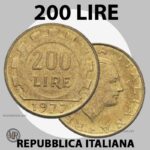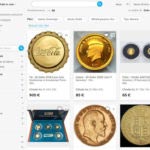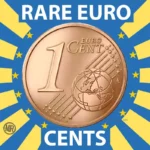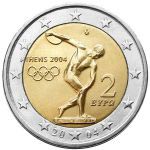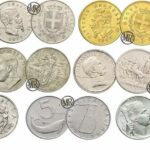If you want to know all the Greek Euro Coins you are on the right page. Below you can read the history, features and values of the Greek coins among the Eurocollection coins.
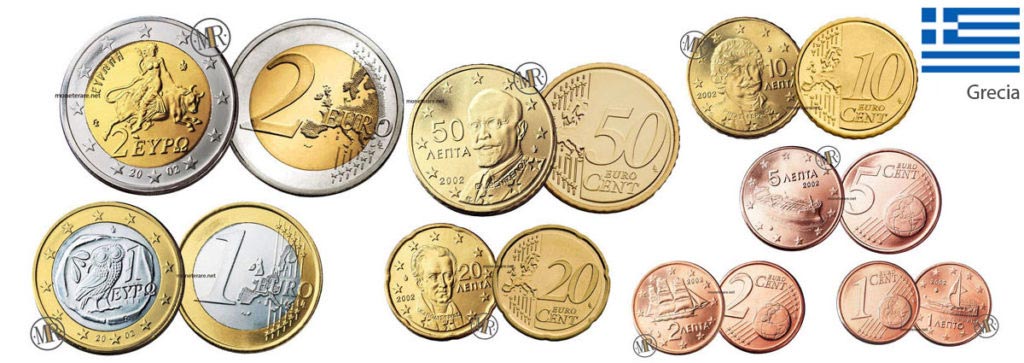
Short History of Greek Coin
We’ve already talked a lot about Greek coins here.
The first Greek currency we encounter in history is the Dracma in 1832, i.e. 10 years after the conquest by the Greeks of independence from Ottoman rule. In this way Greece officially became a Republic.
The Dracma remained in circulation for a very long time, in fact it disappeared only with the introduction of the euro in 2002, the year in which the first coins of this new currency were minted.
During the twentieth century, the previous Greek Drachma, met two moments in the history of devaluation. The first during the Second World War, the second a few years later, in 1953. Practically, “new” drachmas were coined to replace the previous ones, but with very high exchange rates. The first of 1:50,000,000,000, the next instead of 1:1000)
Introduction of the Euro in Greece
The cents and the other Greek euro coins become the official currency in Greece in 2002.
In fact, Greece joined the Eurozone two years earlier, in 2000, together with 11 other countries, but as they were unable to mint coins due to the high quantity required.
Therefore, to remedy this initial and temporary imbalance, a number of coins were minted in different countries and then commissioned to other mints.
One of these countries is Finland. This is where the 1 Euro and 2 Euro currencies were minted, which are marked with the minting symbol S.
The 20 centesimi coin was minted in Spain, in fact in these coins there is the symbol of minting E.
Finally, with regard to the 1, 2, 5, 10 cents and the 50 cents coin minted and circulating in 2002, have imprinted the symbol of minting F, as the seat of minting is France.
However, with this exception, all Greek coins are minted by the Athens Mint, the Greek mint of Halandri.
There is no letter identifying the Greek Mint except the Anthemion, that is the stylized flower present on all the faces of the Greek coins.

Specifications of the Greek euro coins
The Greek euro coins all have a different subject for each denomination. Different but with a common theme.
In other words, the common denominator of the “red” hundredths, i.e. the values of 1, 2 and 5, is the representation of famous Greek ships.
On the other hand, as far as the pieces of 10, 20 and 50 cents are concerned, they have in common portraits of illustrious Greek personalities.
Finally, on the two major denominations, then on the coins of 1 and 2 Euro, there are images related to the history and, in particular, to the mythology of Greece.
Always on this side of the coin, there is a peculiarity that makes them different from the coins of other countries of the Eurozone. In other words, the value of the coin itself, written in the Greek alphabet, has also been inserted.
The symbols were chosen by the Minister of Economy and the Governor of the Bank of Greece from a number of proposals that were presented by a national commission of technicians and artists.
But let’s go down into the singularities and specificities of these coins to better understand their peculiarities.
1 Cent Greek Euro Coins
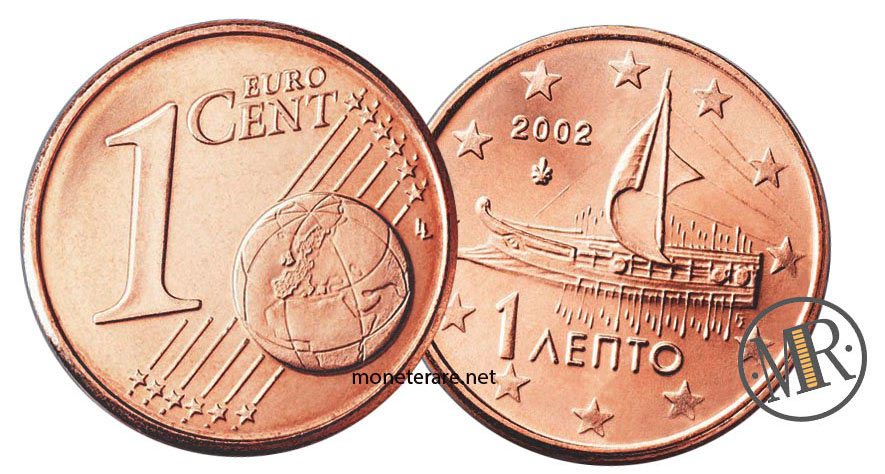
The 1 cent coin of Greece is the smallest Greek denomination.
In the reverse has the same common side to all the 1 cent coins of the countries belonging to the Eurozone.
In the centre of the coin, on the obverse, there is the model of the ancient triremes, the largest warship for over 200 years. It dates back to the times of Athenian democracy in the fifth century BC.
The large sailboat is represented laterally, with sails deployed with the oars protruding from the outside.
Above the hull was engraved the thousandth of minting and, under it, the symbol of the Mint of Athens, or the Anthemion, ie a flower represented in stylized form
Below, instead, we find the image of the number “1” followed by the inscription in Greek characters “ΛEΠTO” (LEPTO).
On the right the initials of the author “ΓΣ”, or Georgios Stamatopoulos.
The outer part of the coin is framed by 12 five-pointed stars, which are the symbol of the European Union.
In the coins dating from the year 2002, if minted by the Mint of France, there is a further mint mark, the letter F. It is inserted inside the star at ’10 o’clock’.
Specifications of the 1 Cent Greek Euro Coins
- Materials: Steel plated with copper ( steel 94,35% – copper 5,65%)
- Thickness: 1.67 mm
- Weight: 2.3 g
- Diameter: 16.25 mm
- Outline: smooth
- Engraver: Areti Michelioudaki
1 Euro Cent Greece: Value and circulation
2 Cent Greek Euro Coins
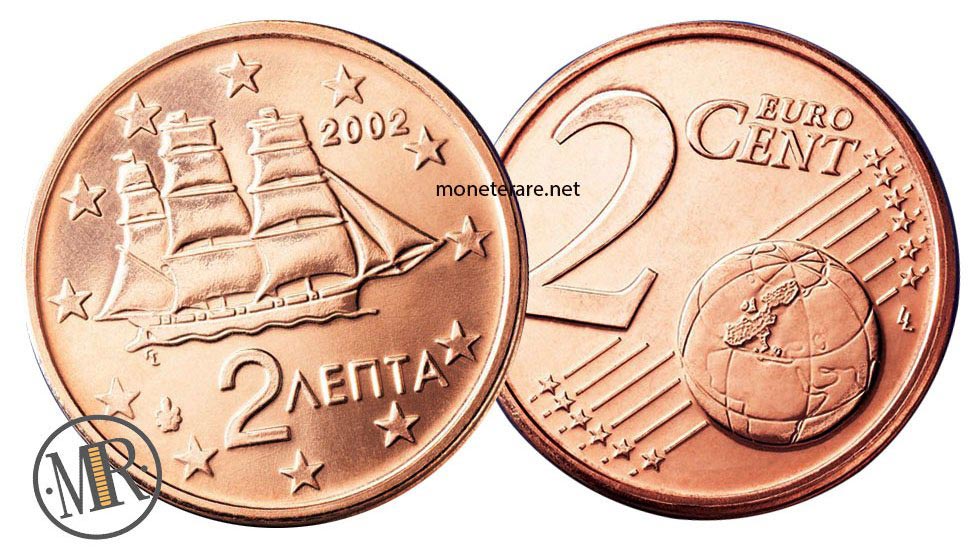
Increasing in value and denomination, we find the coin of 2 cents Euro Greece.
Like the first ones, a ship is depicted in the centre of the coin, in the obverse. In this case, however, the hull is very different from the first.
In fact, we are dealing with a Corvette, a boat used during the War of Independence in the years 1821-1827.
The ship has been engraved on the front, with the stern and bow opposite to the one on the 1 cent coin, which sails the sea with extended sails.
Starting from the lower part of the currency, we find the inscription of the number “2”, flanked by the Greek word “ΛEΠTA” (LEPTA).
To the left of the number are the initials of the engraver ‘ΓΣ’, i.e. Georgios Stamatopoulos, and the Anthemion, as well as a stylised flower representing the symbol of the Athens Mint.
Above the ship, on the upper right, is engraved the thousandth of a coin. In 2002, if the coin was minted by the French mint, the letter F (France) appears inside the 2nd star.
The outer part of the coin depicts 12 five-pointed stars, symbol of the European Union, that embrace this design.
On the reverse side, we find the common face of all the 2 cents of the currencies of the countries belonging to the Eurozone.
Specifications of the 2 Cent Greek Euro Coins
- Materials: Steel plated with copper ( steel 94,35% – copper 5,65%)
- Thickness: 1.67 mm
- Weight: 3.06 g
- Diameter: 18.75 mm
- Outline: Incused horizontal thread
- Engraver: Areti Michelioudaki and Nikos Nikolaou
2 Euro Cent Greece: Value and circulation
5 Cent Greek Euro Coins
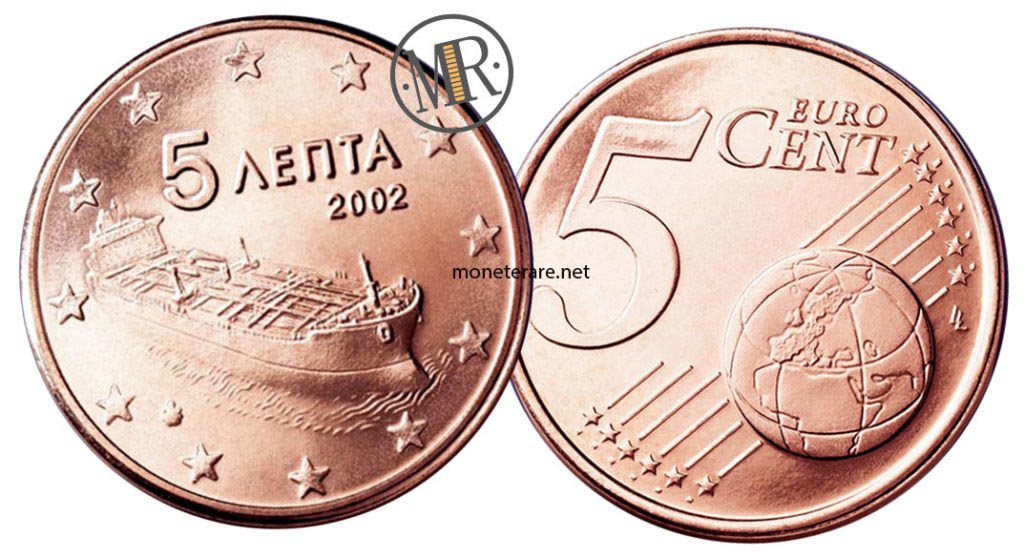
The description of the “red” cents ends with the 5 Eurocents for Greece.
The reverse is the one common to all euro coins, with the inscription 5 cents of the countries of the European Union.
In the obverse, as for the previous coins, we find, for the last time, a hull.
In this case, an oil tanker is represented in the centre of the coin. It is the symbol of the enterprising spirit of the sailors, as well as the skills of the Greek merchant navy.
The ship is depicted in such a way as to give a sense of depth and motion. This is given both by the movement of the waves of the sea and by the position in which it was drawn.
Above the tanker is engraved, starting from the other, the number “5”, flanked by the words “ΛEΠTA” (LEPTA). Under it, we find the thousandth of minting.
Below the ship, on the left, is the symbol of the Athens Mint, the Anthemion, a flower represented in a stylized form.
The initials of the author “ΓΣ”, i.e. Georgios Stamatopoulos, have been engraved under the bow castle of the hull.
The whole is ’embraced’ by 12 five-pointed stars, shown on the outside of the coin, in a circle. They represent the symbol of the European Union.
In the currencies of the year 2002, if minted by the French Mint, there is an additional sign of Mint F (France) inserted in the star at “2 o’clock”.
Specifications of the 5 Cent Greek Euro Coins
- Materials: Steel plated with copper ( steel 94,35% – copper 5,65%)
- Thickness: 1.67 mm
- Weight: 3.92
- Diameter: 21.25 mm
- Side dish: Smooth
- Engraver: Maria Antonatou
5 Euro Cent Greece: Value and circulation
10 Cent Greek Euro Coins
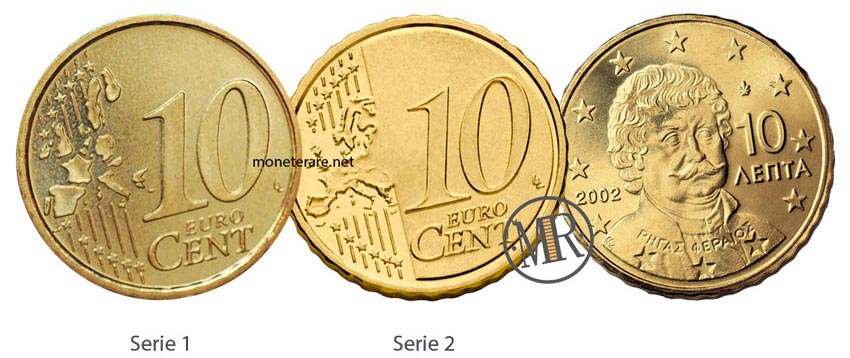
With the 10 Eurocents Greece we move on to the description of the “yellow” cents.
Unlike the “red” cents, as far as the straight drawing of the currency is concerned, the theme changes. In fact, we can see that several important personalities have been represented.
As for the 10 centesimi coin, the illustrious person concerned is Rigas Feraios (1757-1798). His portrait occupies the entire central part of the coin.
Feraios was a forerunner of the Greek Enlightenment and a supporter of the Balkan Confederation and the first to foresee its liberation.
To the left of his face has been engraved the thousandth of mintage. On the right, instead, the inscription of the number “10” and next to it the word “ΛEΠTA” (LEPTA) in capital letters. Then there is the Anthemion, a flower represented in a stylized form, which represents the symbol of the Mint of Athens.
In the lower part of the bust are the beginnings of the author ‘ΓΣ’, i.e. Georgios Stamatopoulos and the Greek inscription ‘PHΓAΣ ΦEPAIOΣ’, as well as the name of the subject depicted (Rigas Feraios).
On the outer edge are engraved 12 five-pointed stars, representing the European Union.
In 2002, if the coin was minted by the French Mint, the letter F (France) appears inside the eighth star.
On the other hand, on the reverso, as for all the currencies of the countries belonging to the Eurozone, we find the same common face of the 10 Cents. In the first series it has the Eurozone countries separated, while in the second series, the 2007 series, it has represented them united.
Specifications of the 10 Cent Greek Euro Coins
- Materials: Nordic Gold (copper 89% – aluminium 5% – zinc 5% – tin 1%)
- Thickness: 1.93 mm
- Weight: 4.1 g
- Diameter: 19.75 mm
- Outline: Rowed with knurling
- Engraver: Pericles Sotiriou
10 Euro Cent Greece: Value and circulation
First Series
Second Series
20 Cent Greek Euro Coins
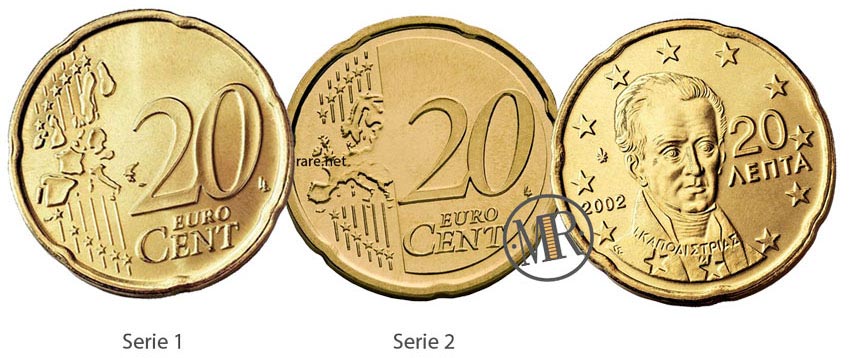
Continuing with the analysis of the currencies the 20 Eurocents Greece are the next.
On the reverse side there is the same side common to all the 20 cents of the countries belonging to the Eurozone. 1st Series 2002 with the eurozone countries separated, instead in the 2nd Series 2007 with the euro zone united.
In the centre of the coin on the right is a portrait of Ioannis Kapodistrias (1776-1831), an illustrious politician and famous Greek and European statesman. He was also the first Greek governor (1830-1831) after the War of Independence (1821-1827).
On the left of the face is engraved the thousandth of a coin. Above it is the Anthemion, a flower depicted in a stylized form, as well as the symbol of the Mint of Athens.
Instead to the right of the politician is placed the number “20” with underneath the inscription in Greek characters “ΛEΠTA” (LEPTA).
Below, on the bust of the illustrious, is engraved in Greek characters the words “I.KAΠOΔIΣTPIAΣ” (I. KAPODISTRAIS) which represents the name of the man depicted. It also contains the initials of the author ‘ΓΣ’, i.e. Georgios Stamatopoulos.
The outer ring is framed by 12 five-pointed stars representing the European Union.
In 2002, if the currency was minted by the Spanish Mint, within the eighth star there is the letter E (Spain).
Specifications of the 20 Cent Greek Euro Coins
- Materials: Nordic Gold (copper 89% – aluminium 5% – zinc 5% – tin 1%)
- Thickness: 2.14 mm
- Weight: 5.74 g
- Diameter: 22.25 mm
- Outline: Wide knurling
- Engraver: Maria Antonatou
20 Euro Cent Greece: Value and circulation
First Series
Second Series
50 Cent Greek Euro Coins
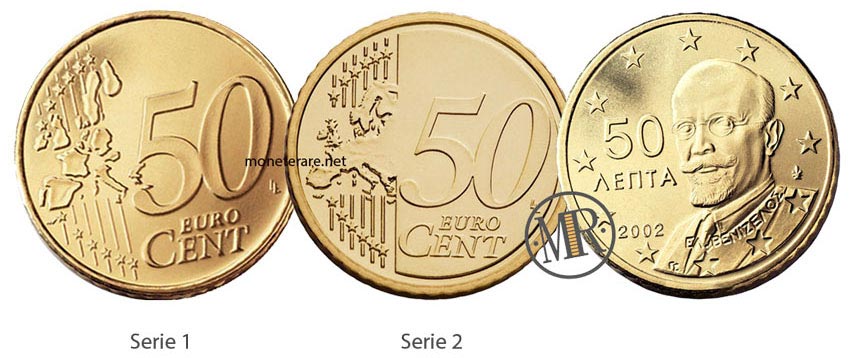
Finally, the 50 Eurocents Greece, are the last to be part of the “yellow” cents.
Al Dritto di questa valuta è inciso il ritratto di Eleftherios Kyriaku Venizelos (1861-1935), una delle più importanti figure politiche greche.
On the right of this currency is engraved the portrait of Eleftherios Kyriaku Venizelos (1861-1935), one of the most important Greek political figures.
On the left of the vote you can see the Greek inscription “ΛEΠTA” (LEPTA) flanked by the value “50”. Below these writings there is the thousandth of minting.
Instead, to the right of the vow, is engraved the symbol of the Mint of Athens the Anthemion, a flower depicted in stylized form.
Continuing with the description, at the bottom, on the bust there is an inscription in Greek characters “EΛ. BENIZEΛOΣ” (EL. BENIZELOS). Also present are the Greek initials “ΓΣ” by the author or Georgios Stamatopoulos.
On the outer edge are the 12 five-pointed stars and the symbol of the European Union. If coined in 2002 by the Mint of France, the letter F from France has been engraved inside the eighth star.
As far as the reverse of the coin is concerned, there is the common face of all the 50 cent coins of the countries belonging to the Eurozone.
The first series of 2002 with separate countries, the second series of 2007 with the Eurozone without borders and with united countries.
Specifications of the 50 Cent Greek Euro Coins
- Materials: Nordic Gold (copper 89% – aluminium 5% – zinc 5% – tin 1%)
- Thickness: 2.38 mm
- Weight: 7.80 g
- Diameter: 24.25 mm
- Outline: Rowed with thick knurling
- Engraver: Nikos Nikolaou
50 Euro Cent Greece: Value and circulation
La prima serie
La seconda serie
1 Euro Coins of Greece
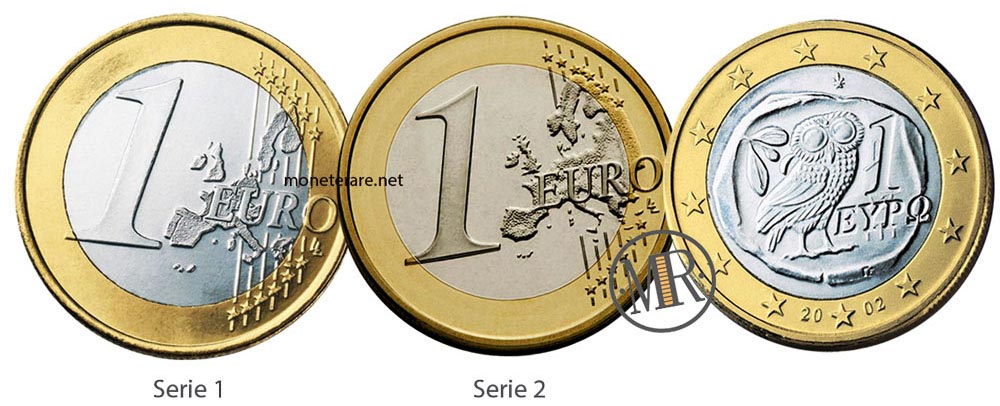
The 1 Euro Greek currency is a bimetallic coin and the largest coin compared to those described so far. It is one of the 8 denominations of the Euro coins.
Description
In the reverse has the same common side to all the 1 euro coins of the Eurozone countries.
In the First Series, the map of the eurozone countries has marked the borders between one country and another, while in the second series of 2007 the countries are shown without borders.
On the other hand, in the Straight, there is an image inherent in Greek mythology, that is, an owl. This animal represents in particular the Owl of Minerva, which already appeared in an ancient Athenian coin of 4 drachmas dating from the fifth century BC. You can see the above mentioned coin on this page: Ancient Greek coin.
Minerva accompanies in the various events, from Homer onwards, Athena, daughter of Zeus, in the various events.
However, it has a strong symbolic value. It symbolizes beauty, love and harmony for knowledge and research in the broadest sense.
To the right of the owl is engraved the value “1” with underneath the inscription in Greek characters “EYPΩ” (EIRO).
At the top, instead, there is the Anthemion, the symbol of the Mint of Athens, or a flower depicted in a stylized form.
On the contrary, at the bottom, there are the initials “ΓΣ” written in Greek by the author and designer Georgios Stamatopoulos. Also below, in the crown, there is the thousandth of minting, divided in two by the sixth Star.
The outer edge is engraved with 12 five-pointed stars, which represent the symbol of the European Union.
In 2002, if coined by the Mint of Finland, inside the 6th star is engraved an S, which stands for Suomi.
Specifications of the 1 Euro Coins of Greece
- Materials: Bimetallic. Outer part: nickel-brass (copper 75% – zinc 20% – nickel 5%); inner part: copper-nickel (copper 75% – nickel 25%).
- Thickness: 2.33 mm
- Weight: 7.50 g
- Diameter: 23.25 mm
- Outline: Discontinuously grooved
- Engraver: Georgios Stamatopoulos
1 Euro Coin of Greece: Value and circulation
First Series
Second Series
2 Euro Coins of Greece
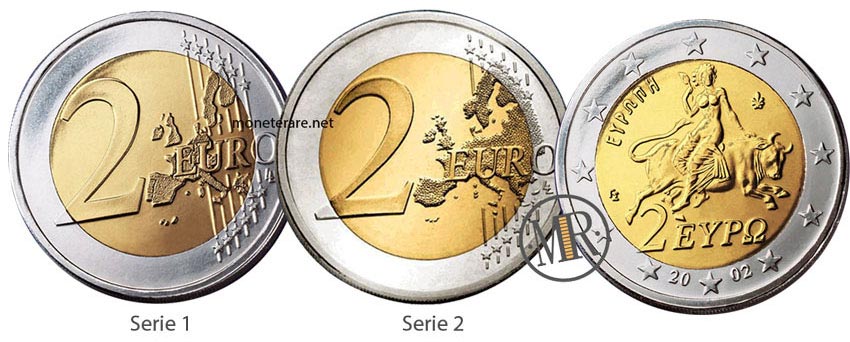
To end this detailed article, let’s talk about the 2 Euro coins of Greece, which are the last coins of the 8 Euro denominations.
Description
This bimetallic currency has the same common face on the reverse side of all the 2 Euros of the Eurozone countries.
In the map of the euro zone of the 1st Series are shown the borders between countries, in the map of the 2nd Series no, the countries are united.
On the other hand, on the obverse side, as in the 1 Euro coin, there is an image that fully reflects the mythology and therefore the Greek history.
At the centre of the coin there is a scene from the mosaic of Sparta from the third century BC, or Europe kidnapped by Jupiter, which takes on the appearance of a bull.
In fact, it is well known that Jupiter often dabbled in turning into different forms and, among other reasons, also to seduce his “preys”.
To the left of this mythological figure have been engraved the initials “ΓΣ” written in Greek, and I am the author and draftsman Georgios Stamatopoulos.
At the top left of the street there is an inscription, again in Greek characters, “ΕΥΡΟΠΗ” (EIROPE).
On the other hand, always at the top but on the right, there is the Anthemion, the symbol of the Mint of Athens, or a flower depicted in a stylized form.
Below, the value “2”, followed by the Greek characters “EYPΩ” (EIRO).
In the crown, on the edge of the currency, is engraved the thousandth of minting divided into two parts by the sixth star.
On the outer edge, there are 12 five stars representing the symbol of the European Union.
In 2002, if coined by the Mint of Finland, inside the 6th star is engraved an S, which stands for Suomi.
Specifications of the 2 Euro Coins of Greece
- Materials: Bimetallic. Outer part: copper-nickel (copper 75% – nickel 25%); inner part: nickel-brass (copper 75% – zinc 20% – nickel 5%.
- Thickness: 2,20 mm
- Weight: 8.50 g
- Diameter: 25.75 mm
- Outline: Finely knurled with the inscription ‘ΕΛΛΗΝΙΚΗ ΔΗΜΟΚΡΑΤΙΑ * ” (Hellenic Republic)
- Engraver: Georgios Stamatopoulos
2 Euro Coin of Greece: Value and circulation
First Series
Second Series
2 Euro Greek 2002
The time has come to dispel a myth and to look once and for all because the 2 Euro Greece 2002 without S is worth as much as the 2 Euro Greece with S!
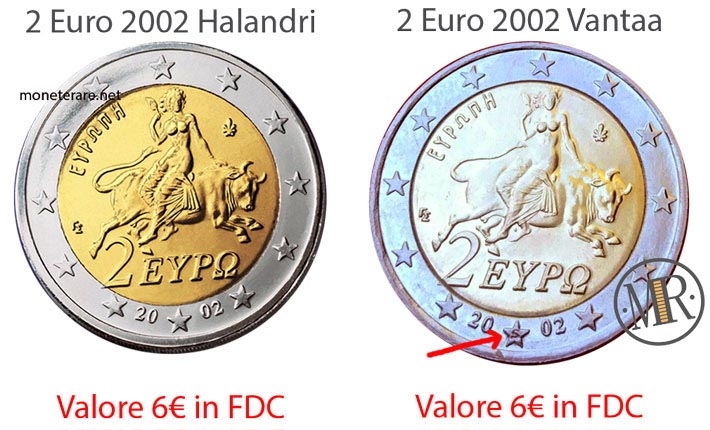
It would be enough to read the history of the 2 Euro Greece to understand it, we wrote it also in this article. In fact in 2002 Greece began to use the Euro as a currency but had problems to mint the amount of coins required.
It was therefore necessary to have some of these coins minted in other foreign mints in order to be within the delivery time.
That is why they were only minted in 2002:
- Mint in Halandri: 75.340.055 + 59.945 BU coins from 2 Euro without S
- Vantaa Mint: 70,000,000 2 Euro coins with the S
In fact, the letter S is the symbol of the Finnish Mint of Vantaa! Because the word Suomi means Finland in Finnish.
2 Euro Greek 2002 Value
- The value of the coins 2 Euro Greece 2002 is 6€ in FDC
- 2 Euro Greece 2002 with and without S is 4.50€ in Spl
- For the 2 Euro Greece 2002 with and without S in BB the value is 3,75€
- Instead the value of the same coin but circulated is 2€
Pay attention: if you find someone offering you the 2 Euro Greece 2002 Coin with S at 250€ or other three-figure figures it’s a scam! If you are offered the 2 Euro Greece 2002 coin without the S at 250€, or other strange figures, it is a scam!
If you have any doubts about the value of your coins you can always ask our opinion in the facebook group to moneterare.net
Do you want to learn more about Euro Coins?
- Two pages you can’t miss: 2 Euro Commemorative Coins and Rare Euro Coins
- The precious Vatican euro coins can be seen here and also the San Marino euro coins
- Here you can see the Malta euro coins and here the Cyprus euro coins.
- Euro coins from Germany can be found here and Euro coins from Estonia and Latvia Euro Coins here.
- Euro coins from France can be found here, as well as Euro coins from Austria.
- Also of great interest are the euro coins from Greece and the euro coins of Luxembourg.
- Here you will find Lithuania Euro coins and Andorra Euro coins
- We also talked about Slovenian Euro coins and Slovakia Euro coins.
- Check also Spanish Euro Coins here and Euro Coins of Portugal here.
- The Netherlands euro coins can be found here and the Ireland euro coins here.
- All precious Monaco Euro coins are here and Belgium Euro coins here


